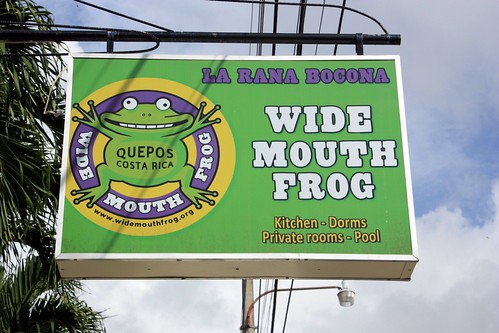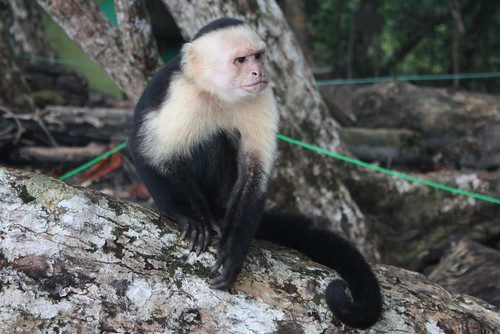With active volcanoes, dripping cloud forests and palm tree lined beaches on both coasts it’s easy to see why Costa Rica is a popular travel destination. It’s home to
a huge variety of wildlife with some 228 mammal, 10,000 plant and 36,000 insect species, all in an area roughly two-thirds the size of Scotland, a quarter of which is safeguarded by more than 75 National Parks, reserves and
protected areas. However, as we knew that we would be arriving during the rainy season we struggled to work out how to make the best of our time and whether we would get to see any wildlife at all, in the end we decided to
just cross the border and see where our travels took us.
We arrived at Panamanian immigration and despite stories of long queues we quickly received our exit stamps. Outside of immigration we were told by an American, that we would
need to prove onward travel arrangements to be able to enter Costa Rica. A lot of countries we’ve visited have this rule, but with the exception of Indonesia its never been enforced. He told us we would have to buy a return
bus ticket to Panama and where we could purchase it. As border crossings are the perfect place for scams we weren’t sure if the guy was being genuine or working in conjunction with the bus company to sell us tickets they
knew we wouldn’t use. As we weren’t tied to time or transport we decided to cross no mans land and see what happened. At Costa Rican immigration depending on your cynicism, we were surprisingly / unsurprisingly not asked
for any documentation and were given our entry stamps hassle free. Although, we’re now not sure that we did everything we needed to to be officially in Costa Rica, as everyone else seemed to have all their belongings searched,
which could make our next border crossing interesting.
Dominical
After spending time on the Caribbean Coast in Colombia we decided to head to the Pacific Coast where the first thing that we noticed was how much rougher the sea was, which
is probably why the Pacific Coast here is so popular with surfers. The water was also noticeably colder, but as it’s still hot during the rainy season it’s not such a bad thing when you need to cool down.

Dominical is
one of the bigger towns in the area, but in what was to become a re-occurring theme we were surprised by how small it was. With no other attractions other than the ocean, we would head to the beach before the heavens opened
around lunchtime sending us scurrying for cover to play cards and hope that the rain cleared up in time to catch a famed Pacific sunset.

It also didn’t take us long to see our first wildlife as a huge iguana strolled passed our window, having a peak in before climbing the tree behind our room. Later in the
evening we also found a golden monkey in the supermarket!
 Quepos & National Park Manuel Antonio
Quepos & National Park Manuel Antonio
Having ‘whet’ our appetite for wildlife we decided to see if the rains would hold out enough to let us see some wildlife at Manuel Antonio National Park. We stayed in
the town of Quepos as it’s much cheaper than staying in the town of Manuel Antonio and because I couldn’t resist the opportunity to stay in the Wide-Mouth Frog hostel, one we can highly recommend. It had everything that
you would expect from a hostel with the added luxury of a pool, while reminding me of the wide mouth frog joke that was a favourite of my pops during my childhood.


Our first experience of a Costa Rican national park certainly lived up to expectations, as it wasn’t very long after arriving at Espadilla beach that we saw a trio of racoons
climbing a tree to try and steal another visitors food, before one of them set about digging in the sand hunting for its natural food, crabs.


I then went for a swim is some serious swell which was totally unsuitable for the snorkeling that we had planned to do, but we were easily compensated by the appearance of
some white headed capuchin monkeys who, like the racoons, were on the hunt for food.


It’s a shame that the animals at Espadilla beach are on the point of becoming a menace, too many humans have either fed or left food lying around that the monkeys and racoons
now expect an easy feed. I even had to squirt water in racoons face after it starting eyeing up our lunch.
At the other beaches in the park, the animals where making an honest living searching for food on their own. The coutis were digging for crabs, while lizards basked on the
rocks and tiny agoutis hid in the undergrowth out of camera shot.

Of course the rain came pouring down in the afternoon, but not before we had seen more wildlife in a couple of hours than we could have possibly hoped to see.
(Do you know the way to) San Jose
From Quepos, we could have headed to the capital but from everything we’ve heard it’s not a nice place due to the crime and apart from a few museums there are very few
attractions that warrant a visit, so along with Napyidaw and Brasilla, San Jose can go down as a capital city we didn’t go to, although that list could get longer very quickly as most of the capitals in Central America sound
similar.
Monteverde & Santa Elena Cloud Forest Reserve
We decided to head inland to see a different side of Costa Rican life, as well as hopefully seeing some more flora and fauna. Monteverde is perhaps Costa Rica's most famous
wildlife location and although we’d been warned that the wildlife is difficult to spot, we decided to go an see what we could find.
In the town of Santa Elena we found a room in the newly opened Sloth Backpackers and went to the supermarket to buy our dinner. While searching the aisles, Jorle the hostel
owner came looking for us as she wanted to show us the three toed sloth in the trees outside her hostel, but we should finish our shopping first because as it was a sloth it wasn’t going anywhere fast.

The next day we decided to hike the Cerro Amigo trail where on a clear day you can see both the Atlantic plains and the Pacific Ocean. But what we wanted to see was the perfect
cone of Volcan Arenal less than 20 kilometers away. After a steep 2 hour trek we arrived at the summit, where we were met with a blanket of white clouds. I suppose that’s what you get for hiking into a cloud forest in the wet season
to try and get views!
Rather than heading to the Monteverde Reserve we decided to go to the quieter Santa Elena Cloud Forest Reserve, in the hope of spotting some Howler monkeys
and the Resplendent Quetzal. It’s also said that on a clear day you can see Volcan Arenal from the parks viewing platform. We ended up spotting none of the three but really enjoyed our hike through the dripping cloud forest.

On our last evening we visited a frog farm and as well as catching up with our old friend the black and green poison dart frog, we saw lots of other frogs, including the most
popular red eyed tree frog and the lesser known 'Stuck on Glass' Frog.

Montezuma
Montezuma is more renowned for its beach life than it’s animals but staying at our hostel you would have hardly known it, as the area around the Luna Llena was teaming with
wildlife, with coutis and monkeys roaming the grounds around our cabin and a racoon that loved to raid the rubbish bins. One evening out of the corner of our eyes we caught something running in the kitchen from under the fridge,
at first we suspected a rat, but it turned out to be a small skunk that was using the fridge as a hiding place after stealing the cat’s food, while the cat was busy interrupting a beer blogging session.

In Montezuma, lizards laze in the shade on top of road signs, snakes sleep in potholes in the road and odd coloured squirrels run around the town. All the animals more than
made up for the fact that the rainy season meant we couldn’t spend as much time at the beach here than we hoped to. After a few days we thought it was time to head into Nicaragua and just hope the border crossing would be
hassle free.

Costa Rica Observations
We immediately liked Costa Rica and received more smiles from the locals in 2 minutes than we received during all of our time in Panama. We were worried that due to the weather
we wouldn't get to see much of the wildlife the country is famed for, but we shouldn’t have been concerned it is literally everywhere and you don’t even need to go to the National Parks and Reserves to see them.
Due its tourist infrastructure and popularity with US retirees and travellers Costa Rica is more expensive than its neighbours, almost everything is quoted in US$ and the conversion
rate to the local Colon can vary wildly. We managed to get lots of good deals on our accommodation due to the low season, although one hostel owner offered us a whopping 12 cent discount per night that we politely declined.
Food is expensive, with the continent standard rice, beans and meat meal costing nearly four times what it did throughout South America, but the local sodas were nice places to eat and interact with the locals, while being a lot cheaper than restaurants. We also found bus travel to be almost criminally cheap even if you do have to wait 2 to 3
hours to catch a connecting bus in each town. Despite the influx of Americans here, the country is not teeming with McDonalds and shopping malls as we expected, there are a few gated communities and golf clubs dotted around, but apart
from that it still felt Costa Rican to us.

Highlights
Favourite Place - Monteverde (Both)
Favourite Attraction - N.P Manuel Antonio (Both)
Favourite Food - Casado con Bistec (Jo) Casado con Carne en Salsa (Ryan)
Favourite Beer - Imperial (Ryan)
Favourite Drink - Aguadulce (Jo)
Lowlights
Having to wait for hours to change transport in Puntarenas, on three separate occasions!

For those of you thinking of possibly travelling to the region: Costs in USD
Accommodation - $20 for a private room in hostel (Double in high season)
Restaurant meal - $5-7
1L Bottled Beer - $2.25
500ml Soft Drink - $1
1.5l Bottle of water - $1.25
Bus - $0.75-1 / hour
Ryan y Jo
Photos: http://www.flickr.com/photos/dojo77/